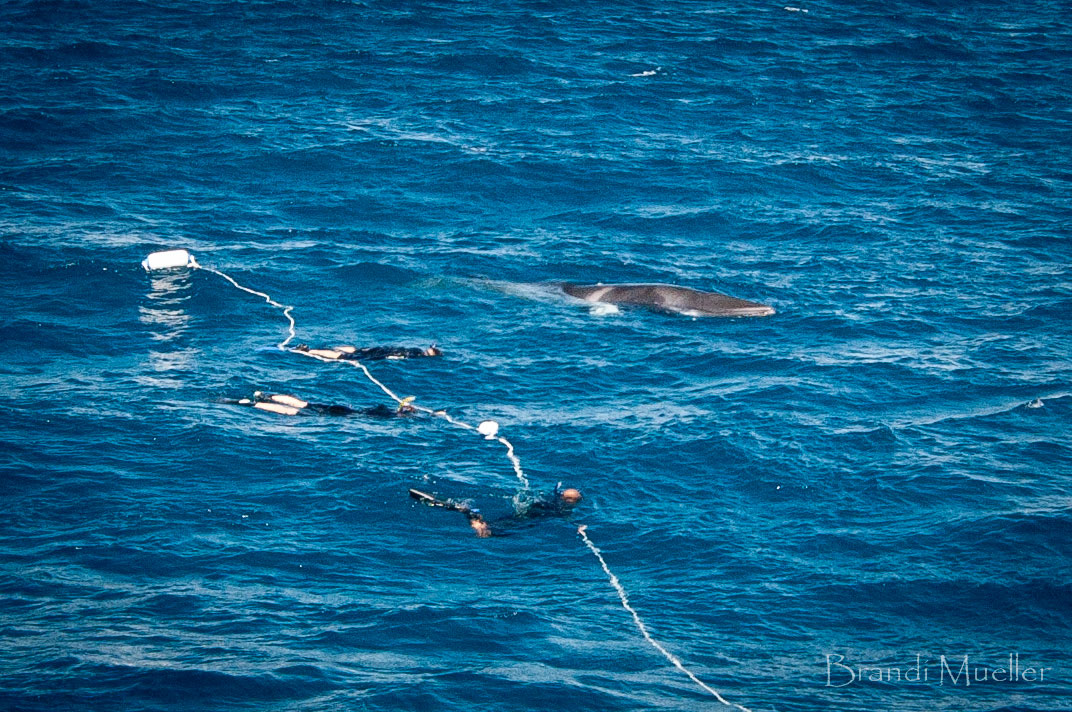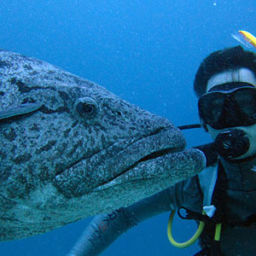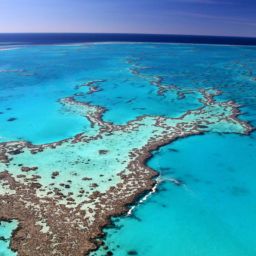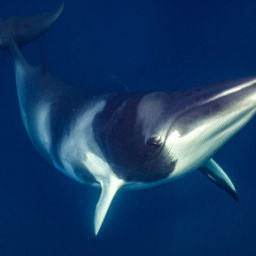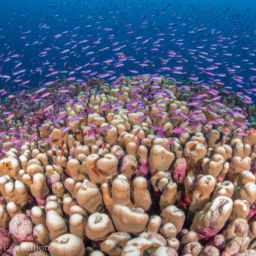* This is a guest post by Brandi Mueller
The captain slowed the boat to a completely stop and the crew threw out two 100ft lines with buoys from the back of the boat. And then we waited. As we stared out over the water behind the boat with our snorkel, mask, and fins ready; we saw a fin, similar in size to a large bottlenose dolphin, surface near the lines. Then it came up again closer to the back of the boat and we could see the distinct white pectoral fins and ring around its back through the water. Soon another dwarf minke whale joined the first, seeming to be checking out the lines and buoys behind our boat.
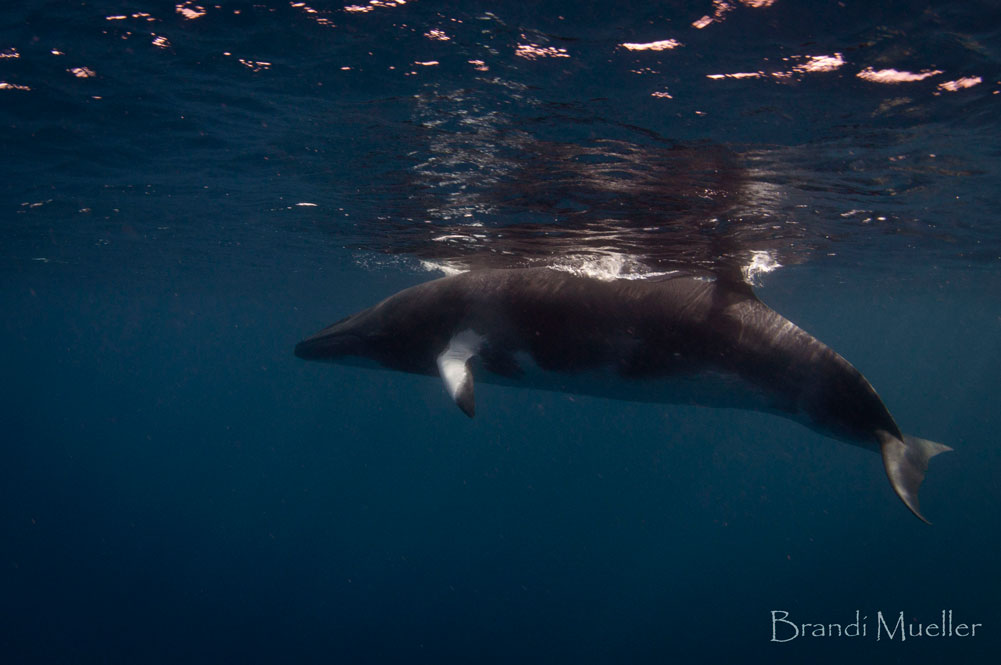
We waited impatiently for the crew to give us the okay so that we could slowly and quietly slide into the water. Once given the okay we all got in the water, holding onto the lines. For a few minutes we didn’t see anything and then suddenly appearing out of the blue came an eight foot minke alongside the line. He swam from the far end of the line to the back of the boat, appearing to look at each and every one of us, as if he was checking out what we were and what we were doing. Then the second joined the first and they crisscrossed underneath us coming up to breathe on one side and then diving back down below us.
Dwarf minke whales, (Balaenoptera acutorostrata), have commonly shown up near the Ribbon Reefs of the Great Barrier Reef in the austral winter, and I wanted to swim with them. After some research I headed to Cairns, Australia to join Mike Ball’s Spoilsport on one of their minke whale charters. Mike Ball offers three, four, and seven-day minke charters during June and July that offer both snorkeling with minke whales and scuba diving on the Great Barrier Reef.
Dwarf minke whales are sighted from March to October in Australia; with 90% of sightings in June and July west of the Ribbon Reefs (of course this is where many of the dive boats usually go, so we may just get more reports from this area). Mostly seen as individuals or a pair, for some reason the minkes seem to congregate in larger groups during human-whale encounters. We had three encounters during my week onboard and one had six whales show up for a four-hour encounter.
Dwarf minkes are baleen whales that feed mostly on krill and small schooling oceanic fishes. Similar to other whale species such as humpbacks, it’s thought the minkes go to warmer waters during the winter to mate and give birth and they only eat while in the sub Antarctic waters during the summer. Dwarf minkes have been reported along both coasts of Australia, New Zealand, New Caledonia, and South Africa. Measuring up to 26 feet dwarf minkes are slightly smaller than other minke species.
After our first day with a four-hour minke encounter most of the passengers were diving on a site called Lighthouse Bommie when we heard someone banging rapidly on their tank. We looked up and a minke was swimming right over top of us. It then circled the bommie and came back for another look at us before swimming away. The crew put the lines out again and before we knew it there were two minkes hanging around the boat. When the dive was done we took off our tanks and got back in the water with our snorkels. Most of the rest of the afternoon was spent on the lines watching the minkes swim circles around us.
The most amazing part of the dwarf minke whale encounters is that the whales entirely decide the encounter. There is no chasing the whales by boat or swimming after them. It seems the whales actually come up to the boat and the divers/snorkelers to check us out and interact with us. They also decide how long they will stay and how close they get.
Whale-human interactions have been limited in other areas, but The Great Barrier Reef Marine Part Authority grants an endorsement to vessels such as Mike Ball’s Spoilsport to conduct dwarf minke whale snorkeling. With that endorsement comes a code of practice to reduce negative impacts on whales. These include no touching or swimming after the whales. Swimmers must stay calm and quite in the water and hold the line at all times. Divers are not to swim towards the whales, but instead to stay still and let the whale chose how close it wants to be. No flashes or strobes are allowed for photography and video. Encounters with the minke whales are completely up to the whales. The interactions are based on voluntary approaches by the whales and it is strictly regulated by the boat crew that snorkelers are not allowed to swim after or chase the whales, but instead stay motionless while holding onto the lines.
Mike Ball also works with James Cook University’s Minke Whale Project and a researcher is brought onboard for each charter to continue their research and share their knowledge with passengers. Nightly lectures are given and the researchers are available throughout the trip to ask questions. The knowledge of dwarf minke whales is very limited, and associations between companies such as Mike Ball and research organizations like the Minke Whale Project help to expand this knowledge and allow us to learn more about these amazing creatures while providing amazing encounters for us.
Passengers are also encouraged to help the research by contributing photos to the project. Identification of whales has been predominantly due to photos submitted by snorkelers and divers and with information as to where the photos were taken, researchers have developed a better understanding of where the whales are and how many of the same whales are returning to similar areas.
There is just something amazing about being in the water with whales and the feeling you get when these massive creatures swim alongside you and seem to stare right at you. The Spoilsport minke whale charters are a great way to have a sustainable and non-invasive encounter with the whales while also learning about the, and being able to contribute to the continuing research of these amazing ocean creatures.
More information:
http://www.minkewhaleproject.org
http://www.mikeball.com


